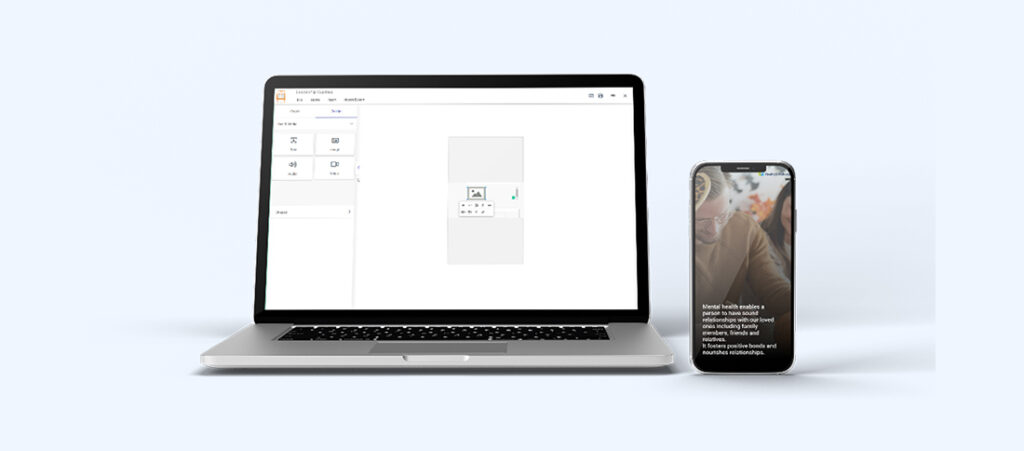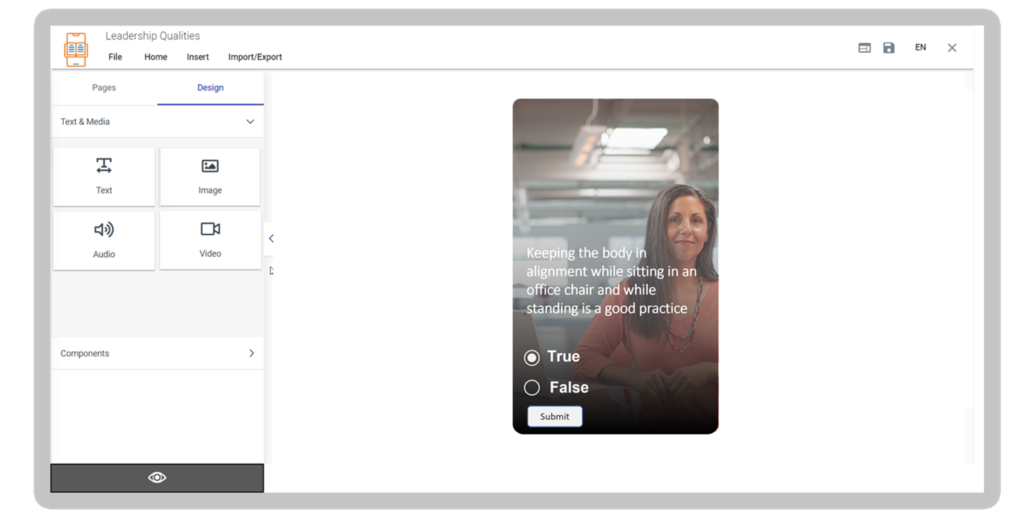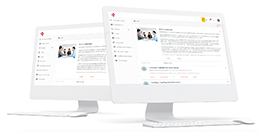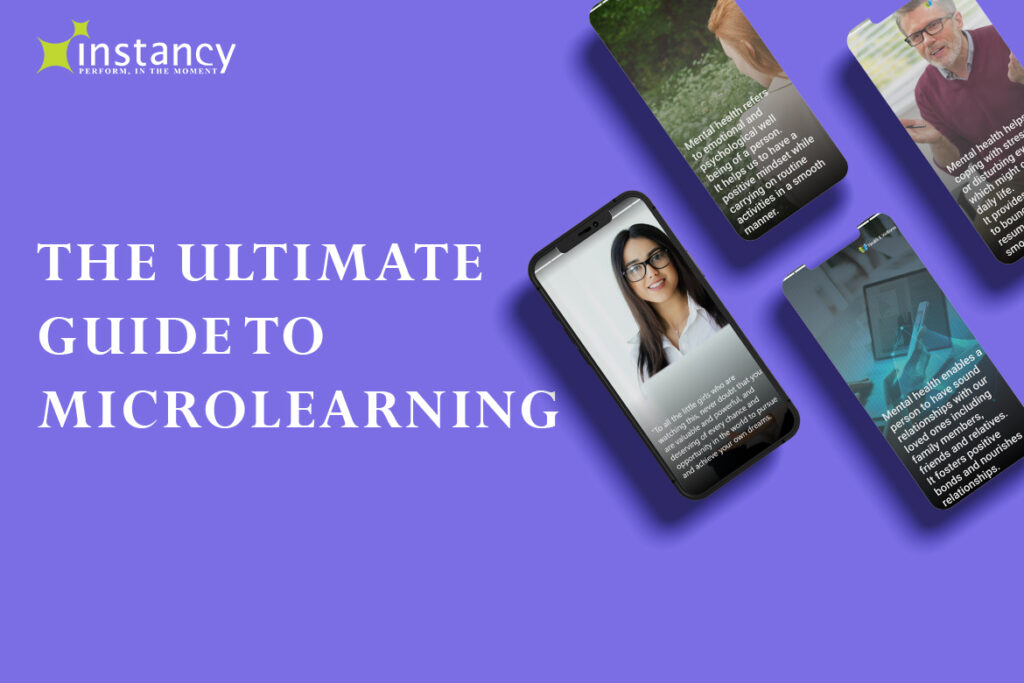Table of Contents
- What is Microlearning?
- Principles of Microlearning
- Why is Microlearning Important for Delivering Effective Learning?
- Mobile Learning and Microlearning: A Natural Combination
- Disadvantages of Microlearning
- Best Practices for Microlearning
- How to Build a Mobile-first Microlearning Content Without Coding?
- Web-based Authoring Tool for Creating Mobile Microlearning
Are you tired of scrolling through the extensively long paragraphs present on the vast eLearning courses to seek a simple snippet of information? Do the endlessly running words make you even more confused about your original query?
Fret not as microlearning is the go-to solution for these problems. This article explores the various facets of microlearning and how it fuses effortlessly with Mobile Learning. It also offers an overview of the best practices which one should follow for microlearning.
What is Microlearning?
Essentially, the whole concept of microlearning focuses on creating bite-sized information in small learning units so that the data can be conveyed in a hassle-free and easy manner while keeping the learner engaged. Microlearning is accessible on any device ranging from desktop computers to smartphones. However, microlearning is more conducive for mobile consumption.
Mobile users prefer to access content for short bursts of time while they are on the go. Simultaneously, it is an imperative mode of eLearning as it can help the learner to provide a broad overview or outline about the topic. It is also highly engaging as it uses various audio-visual aids to retain the learner’s attention. Some of the most popular formats used for microlearning are:
- Small phrases or paragraphs ( text)
- Illustrations and photographs (images)
- Short Videos (audio and visual aids)
- Speech snippets, music, or voiceovers (audio aids)
- Tests, Quizzes, or Games (retention
One can select a preferred mode and simplify a topic through microlearning. Due to its visual appeal, it also attracts a large audience and engages the learners. It is a highly effective tool while imparting compliance training or skills training. The core information is presented in a defined way to the learner quickly to render clarity about a topic. It is also crucial to ensure that this format of learning should align with the topic seamlessly. For example, it is good to choose various illustrations and photographs when one explains the issue of biodiversity or evolution. It will help the learner to co-relate the concepts with various visual aids and aid seamless learning.
So, we can summarise the importance of microlearning through the following points:
- It is less time-consuming and can help to create a large amount of content swiftly.
- It is inexpensive and needs only a handful of resources and instructors.
- It is a versatile tool that can cover a variety of topics.
- Due to the presence of various audio-visual aids, it’s much more engaging than regular learning content.
- It helps the learners to retain the information for a more extended amount of time.
- It’s more user-friendly and provides learner flexibility.
Principles of Microlearning
Certain aspects are common and should be kept in mind while designing a microlearning module. By keeping these factors in mind, one can build a practical microlearning module that will ease the process of learning:
- Microlearning follows a focussed approach and targets one particular topic. It is specific in nature and concise, following set and distinctive learning objectives.
- Information is conveyed in short bursts and is usually brief. The topic is generally covered in under five minutes.
- Accessibility and flexibility are vital components of microlearning, as this application aims to facilitate learning from anywhere. It does not restrict the flow of learning to a particular device; instead, it gives complete flexibility to the learner.
- Microlearning juxtaposes various media formats, including images, audio clips, podcasts, etc., to create a more interactive sphere for the learner.
- Through the use of Space Learning, learners can retain the information in a better way. Integrating space learning will help to enhance and improve the learning experience.
Why is Microlearning Important for Delivering Effective Learning?
In recent years, microlearning has picked up momentum and has become a popular resort for learning, implementing, and training learners worldwide in different fields. The main benefits of microlearning in the context of learning are:
- Affordable: It is highly pocket-friendly to develop microlearning courses as it requires fewer resources and few instructors. It does not need specialized tools to create and allows the construction of the software with ease.
- Extremely engaging: Due to various multimedia and audio-visual aids, microlearning is exceptionally appealing and engaging to the learner in contrast to the usual aids of eLearning.
- Retention: Microlearning engages various senses and is, therefore, helpful for the learners to retain over time. It also helps the learners to keep note of the crucial pointers and understand the topic well.
- Applicability: Microlearning is easy to incorporate for learning or training in workplaces as it helps to understand and retain the topics in a simple manner. Due to increased retention, the topics and principles learned can be easily applied on the job or while undertaking a task.
- Flexibility: Microlearning can be accessible from everywhere as it is also available in mobile learning. Learners can use it as per their ease and schedule without being constrained.
Microlearning is undoubtedly paving the way to make learning a fun-filled and futuristic alternative. The users can enjoy added flexibility and retention while learning a new task or assimilating further information.
Mobile Learning and Microlearning: A Natural Combination

Nowadays, everything and anything is possible through a click of our fingers. Mobile learning is no exception to that rule. A whole gamut of information ranging from various subject areas is readily available to users, irrespective of bounds. Thanks to the ever-evolving technology, one does not need to rush to a nearby computer system to gather information for academic or non-academic purposes. Attaining knowledge through various sources is available in the palm of one’s hand by a mobile device and the presence of the internet.
It also enables flexibility as one can use mobile learning and access content easily, even on the go or in remote areas. It helps the learner to assimilate knowledge after working hours or at one’s own convenience and comfort. Thus, it isn’t surprising to know that according to Techmark, an average user checks their mobiles 221 times and touches them over 2000 times in a single day. Hence, learning increases exponentially through the usage of mobile phones.
According to Google, a large majority, i.e., 80% of the world’s population, uses smartphones. Millennials comprise the primary global workforce and are one of the most prominent contributors to evolution and development. Statistics show that nearly all millennials, i.e., 97% own and use mobile phones. So, a considerable chunk of the population uses their mobile devices to seek solutions or find information. Thus, learning through mobile gives access to an unlimited reservoir of information through various sources and experts.
The advantages of mobile learning are as follows:
- It is a flexible tool and offers a wide variety of sources for learning.
- It is an appropriate platform for individual or group learning.
- It provides users complete control and feasibility to access their material according to their own time.
- It is a highly interactive medium and helps to retain the attention of the user.
- It provides access to various multimedia tools to develop a deeper insight into the topic.
- The user can access the material even from remote locations and according to their schedule.
Disadvantages of Microlearning
Microlearning has simplified eLearning. However, its shortcomings cannot be overlooked. The main disadvantages of microlearning are as follows:
- Microlearning provides a brief outlook about the selected topic and is not ideal for subjects that require in-depth information or complex knowledge.
- Microlearning enables the learner to cover only one sub-topic and hence limits the area of knowledge.
- Microlearning is interactive and uses various forms like gamification and other forms of media. A particular topic might get distracting as the learner might want to overdo it even though they have already understood the topic at hand.
- Microlearning can raise challenges about structure and organization. A complex topic has to be divided into multiple bits. Therefore, it requires precision and a structured approach.
Best Practices for Microlearning
Despite posing particular challenges, microlearning is beneficial in aiding learners to retain knowledge effectually. The best practices for designing a microlearning module are:
- One Focal Point: Since microlearning modules provide information about a particular area of knowledge, it is mandatory to have a central learning objective to ensure that the learner stays on track.
- Understand the Target Audience: Understanding the learners and their specifications is essential before designing the content. They should find the content relatable and easy to comprehend.
- Inclusion of Multimedia: Including various tools like images, music, games, etc., ensures learner’s engagement and improves retention.
- Mobile-Friendly: One of the main objectives of microlearning is that users should assess it from any corner of the world. Therefore, the content should be mobile-friendly to allow complete flexibility in time or place to the learner.
- Personalization: The content needs to have relevant topics for the background of the learner. This factor will enable the user to have self-paced learning at ease.
How to Build a Mobile-first Microlearning Content Without Coding?
Microlearning is a powerful tool that enables a person to learn with ease and flexibility from anywhere. It is necessary to build a microlearning course according to the needs and specifications of the learner and target audience.
The fundamental aspects that one should keep in mind while designing a practical microlearning experience are:
- Determine the learning material: The content should be carefully chosen and should cover the critical areas of the topic to deliver bite-sized information to the learner efficiently.
- Division of learning content: Microlearning predicates the concept of breaking a substantial chunk of knowledge into smaller and simpler units for consumption. Each branch of microlearning carries information that covers one learning objective at a time.
- Learner-based approach: The microlearning modules must be created in an easy-to-understand language and include the vital points. It should consist of the terminology which is pertinent for the learner and their background.
- Inclusion of multimedia: Microlearning is highly engaging and holds the attention of the learner. One should include various audio-visual aids to provide clarity and engage the reader.
- Regular Updates: Information evolves with time. It’s pertinent to develop the content or information with the latest ongoing trends to keep learners up to date with the current happenings.

Web-based Authoring Tool for Creating Mobile Microlearning
Creating a mobile micro-learning tool enables the user to access learning from even the remotest location or the comfort of their home. Although, the question arises how should one go about the entire process?
Instancy also offers the unique feature to convert pre-defined page templates into highly engaging eLearning content. One can convert PowerPoint slides or Word documents into eLearning content. Furthermore, one can add various multimedia objects like pictures, videos, and audio clips to enhance the experience to a whole new level.
Instancy offers seamless integration with a Learning Management System and thus enables the learner to exercise complete flexibility through any device ranging from desktop to mobile. Instancy provides authoring tools that are mobile responsive and additionally also help to track learners’ progress.
- Through the ‘no developmental’ code tool, the mobile application includes a range of functions, including discussion forums, gamification, knowledge sharing, and chat. It helps the learner to go beyond the existing sphere of knowledge and attain holistic information.
- Instancy is also a unique platform that offers learning and assessments in offline mode. It also helps to track one’s progress as it stores learners’ progress across various platforms. Its automatic synchronization with multiple devices helps the learner to be on the right track.
- Instancy gives complete access to multimedia content like video, audio, and various podcasts enabling a user-friendly and engaging experience.
- Uploading and sharing documents, including spreadsheets and PDF is an effortless process as the learner can access any learning material on the go.
Instancy provides a wholesome approach to elevate learning to a whole different level while integrating the best user-friendly experience with efficient tools to enable an integrated approach towards learning. Click here to get started!

Summary
In a nutshell, microlearning refers to knowledge that is concise, clear, and presented in bite-sized learning units. Microlearning content is brief, as denoted by the term “micro,” but it must be able to stand alone as a single unit of learning. Microlearning content may now be readily created using a web-based authoring tool like Instancy without the need for specialized coding skills. By combining microlearning and mobile learning, you’ll receive improved learner engagement, participation, knowledge retention, and learning completion rates. Learners can improve their abilities on the go, and the microlearning courses can be used as a short reference guide to refer to any information at any time. As a result, microlearning is unquestionably here to stay.





